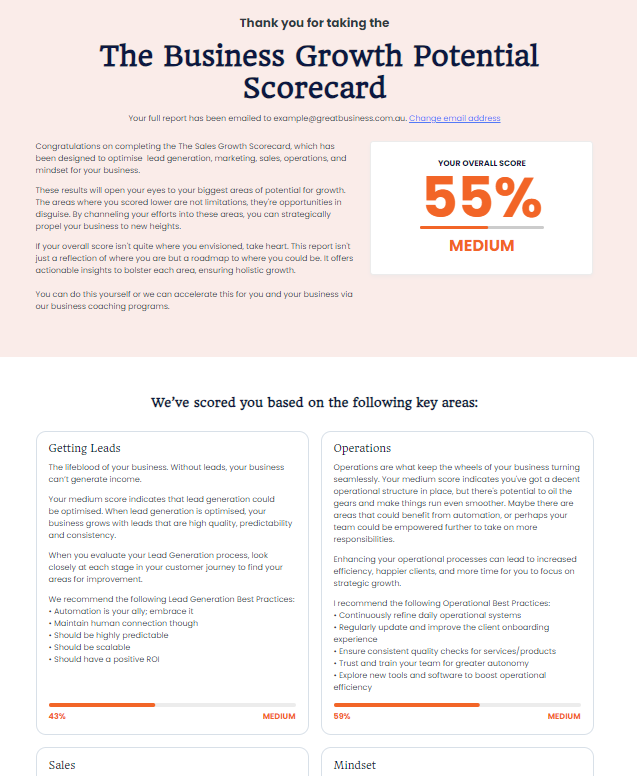As an entrepreneur, you’re probably always on the lookout for ways to expand your busines and hit new revenue targets? If you’re feeling like you’ve reached a plateau in your current market, it might be worth considering a market development strategy.
Now, you might be wondering: “What on earth is a market development strategy, Angela?” It’s all about identifying and developing new market segments for your current products.
It’s a fundamental type of marketing growth strategy that can unlock a new pond to fish in, allowing your business to grow beyond it’s current boundaries.
In this article, we’re going to go deep on market development strategies, to show you why they are incredibly important for the health and growth of your business, especially as you look to scale.
Stay tuned!
What is a Market Development Strategy?
In the simplest terms, a market development strategy is a business growth plan that identifies and develops new market segments for current products.
It’s about exploring new territories—geographical, demographic or even new usage situations for your existing offerings. The main goal here is to reach new customers without having to create new products.
Why is it essential? Well, it’s one of the key avenues for your business growth.
Picture your business as a tree. Just like a tree needs new branches to grow and thrive, your business needs to expand into new markets to stay competitive and flourish.
It’s all about stepping outside your comfort zone to discover uncharted territory and harness the power of new audiences.
Why is it Important to Have a Market Development Strategy?
The power of a market development strategy is monumental. It can be the bridge that connects your products or services with fresh eyes, new audiences, and untapped opportunities.
Think of it as a catalyst for your business’ growth. Rather than waiting for opportunities to knock on your door, a solid market development strategy allows you to actively seek them out.
It allows your business to diversify its customer base, increase market share, and ultimately, boost revenues. Remember, putting all your eggs in one basket (market) can be risky; a diversified market base offers better stability.
It also encourages innovation and creativity within your team. It pushes everyone to think outside the box, understand different customer needs, and adapt. It’s not just about business growth but also about nurturing a growth mindset within your organisation.
In the business world, opportunities don’t just fall into your lap—you’ve got to seek them out, and a market development strategy is a roadmap to find them. Trust me, that roadmap can lead you to some exciting places!
Examples of Market Development Strategies
There’s no one-size-fits-all when it comes to market development strategies. What works best for your business will depend on your unique situation and goals.
However, to get your creative juices flowing, let’s look at common strategies and the benefits they bring.
Geographical Expansion
This involves taking your existing product or service to a new city, country, or continent. It’s like Starbucks taking its signature brew from Seattle to Sydney, opening up a whole new customer base.
The benefit? You’re expanding your audience reach and potentially boosting revenue.
Targeting New Demographics
This is about reaching new customer segments with your current offerings. For instance, a toy manufacturer that typically targets children might start marketing to collectors.
The beauty of this approach is it allows you to tap into new customer groups without changing your product.
Exploring New Sales Channels
From opening an online store to partnering with other retailers for distribution, there are plenty of ways to reach customers.
Ever notice how you can buy your favourite branded clothes both online and at different retail outlets? It’s about accessibility, making it easier for customers to purchase your products.
Strategic Partnerships
By partnering with a non-competing business that has the audience that you want to target, you can cross-promote each other.
Take the example of Spotify and Uber, which teamed up to allow riders to play their own music. It enhances the user experience while promoting both brands.
Seasonal Marketing
If your product is popular during a specific season, why not market it for a different one?
An ice cream shop might introduce hot chocolate in the winter, inviting customers to indulge all year round. This strategy helps to keep your business relevant across different seasons.
Repackaging or Rebranding
A simple redesign or a slight tweak in your message can appeal to a different market.
Lego, for example, launched Lego Architecture for adults, keeping the product the same but changing its presentation. It’s about revisiting your packaging or branding to attract a new group of customers.
Community Initiatives
By supporting local events or charities, you can not only give back to the community but also raise your business’s profile among a new audience. It’s a win-win, building your brand image while making a positive social impact.
Price Adjustment Strategy
Lowering your price point can attract a new demographic. Similarly, introducing a premium version of your product can appeal to customers willing to pay more for a higher quality or additional features.
It’s all about playing with price to appeal to different customer segments.
Real-Life Examples of Market Development Strategies
Now, it’s all well and good discussing the theory, but real-life examples can truly bring the concept of market development strategy to life.
Let’s explore some noteworthy instances of how global brands have utilised this strategy to expand their reach and enhance their business growth.
- Starbucks: This renowned coffeehouse chain didn’t just stick to its US origins. Through market development, Starbucks has spread the aroma of its coffees to over 80 countries. By understanding local tastes and adapting accordingly, they’ve not only grown but also ingrained themselves into diverse cultures worldwide.
- Nike: Remember our chat about upselling? Nike has used this strategy in a slightly different way. Rather than just focusing on their traditional market, they’ve developed products for new demographics such as women, children, and athletes at various levels. By doing so, they’ve opened up new avenues for growth and brand loyalty.
- Uber: Talk about geographical expansion! Starting from San Francisco, Uber hopped from city to city, crossing oceans and continents. Now operating in over 700 cities, their ride-sharing service has truly become global, illustrating the immense power of geographical market development.
- Netflix: Finally, we can’t ignore the digital sphere. Netflix has successfully employed electronic market development, expanding its streaming services to over 190 countries. By tailoring content to local preferences, they’ve managed to captivate audiences around the globe.
So you see, market development isn’t a mythical concept. It’s a tangible marketing growth strategy that real businesses use to propel growth and expand their reach.
Maybe it’s time to take a leaf out of their book?
How to Develop a Successful Market Development Strategy
Creating a successful market development strategy doesn’t happen overnight. It’s a process that requires time, thought, and a fair bit of legwork.
But don’t worry, I’ve got you covered. Here’s a step-by-step guide to help you make it work.
Step 1: Understand Your Current Market
- Analyse your existing customer base. Who are they? What do they love about your product or service? You can use online surveys or quick phone calls to get this info.
- Investigate your competitors. What are they doing well? What can you do better?
- Examine your product performance. Look at sales trends, customer feedback, and product returns to see how well your product or service is performing.
- Use digital analytics tools like Google Analytics to track customer behaviour online.
Step 2: Identify Potential Markets
- Look into geographical expansion. Is there a city or country that might love your product?
- Investigate demographic expansion. Could your product appeal to a different age group, gender or income level?
- Consider different industries. Could your product be used in a different field?
Step 3: Conduct Market Research
- Use surveys or interviews to understand consumer behaviours, needs, and desires in these new markets.
- Read up on market reports and data to understand the market size, growth rate, and competitive landscape.
- Hire market research firms if you need more comprehensive or specific data.
Step 4: Segment Your Market
- Divide your market into distinct segments based on shared characteristics like age, income, lifestyle, or product usage.
- Use customer personas to help visualise these different segments.
Step 5: Evaluate the Attractiveness of Each Segment
- Consider market size, growth potential, competition level, and your product fit for each segment.
- Use a matrix or scoring system to rate each segment and help you prioritise.
Step 6: Select Your Target Market
- Choose the segments that align best with your business capabilities, resources, and goals.
- Balance the effort required to penetrate each market with the potential return on investment.
Step 7: Develop a Value Proposition
- Understand what drives your new customers’ buying decisions.
- Craft messaging that resonates with those motivations and communicates the unique value of your product or service.
Step 8: Design Your Market Development Strategy
- Determine your pricing and distribution strategy for the new market.
- Outline your marketing and sales approach. What channels will you use? How will you attract customers?
- Identify potential partnerships or alliances that could support your market entry.
Step 9: Implement Your Strategy
- Roll out your marketing, sales, and distribution plans.
- Be prepared to adapt as you get feedback from the new market.
Step 10: Evaluate and Refine Your Strategy
- Monitor your progress through key performance indicators (KPIs).
- Gather customer feedback to understand what’s working and what needs improvement.
- Be ready to refine your strategy based on your performance and changes in the market.
Things to Consider When Creating a Market Development Strategy
Market development is exciting, but before you take the plunge, it’s essential to consider a few key points. Here are some important things to consider when you create your strategy:
Understanding Cultural Differences
Each market has its unique cultural nuances that can significantly impact how your product is received. From language to consumer habits, make sure you thoroughly understand these cultural distinctions and reflect them in your strategy.
Regulatory Environment
Different regions come with varying legal and business regulations. It’s crucial to navigate these carefully to avoid any compliance issues down the line. Consulting with local experts or legal professionals could be beneficial.
Customer Need
Is there a demand for your product in the new market? Don’t assume that because a product is popular in one place, it will be elsewhere. Conduct thorough market research to get this information.
Competition
Who are your competitors in the new market? What are their strengths and weaknesses? Competitive analysis can provide valuable insights to shape your entry strategy and unique selling proposition.
Financial Implications
Last but certainly not least, you need to evaluate the financial aspects. Consider the costs of entering the new market and set realistic revenue expectations. A detailed financial analysis will help ensure that your strategy is not only viable but also profitable.
Benefits of Creating a Market Development Strategy
Creating a market development strategy may seem like a daunting task, but the benefits it brings can significantly outweigh the effort. Here are some of the key benefits:
Increased Revenue
By expanding into new markets, you’re opening the doors to a whole new customer base. This can lead to increased sales and, consequently, higher revenue.
Risk Diversification
Relying solely on one market can be risky. By diversifying into different markets, you can spread the risk and make your business more resilient to fluctuations in individual markets.
Competitive Advantage
By venturing into new markets before your competitors, you can establish your brand, create customer loyalty, and gain a strong foothold that could prove difficult for future competitors to shake.
Innovation Stimulus
Entering new markets often requires adapting your products or services to suit local tastes. This can encourage innovation and lead to the development of new ideas and products.
Common Mistakes to Avoid When Creating a Market Development Strategy
As with any strategic planning, there are pitfalls to avoid when creating your strategy. Being aware of these common mistakes can help ensure your efforts aren’t wasted and that your strategy is poised for success.
1. Neglecting Market Research
Skipping in-depth market research or rushing through it is a major misstep. An understanding of the new market’s dynamics, consumer behaviour, and competitive landscape is fundamental to developing a strategy that truly resonates with the audience.
2. Underestimating Cultural Differences
Each market has its unique set of cultural nuances, and failing to account for these can lead to a lack of connection with your new audience. Ensure your strategy embraces these differences and that your product, messaging, and branding align with the local culture.
3. Lack of a Clear Value Proposition
Your product or service needs a unique selling point to stand out in a new market. Without it, you risk blending into the background noise of the competition.
4. Overlooking Legal and Regulatory Requirements
Different markets have varying regulatory environments. Overlooking these can lead to legal hiccups, penalties, and a damaged reputation. Always make sure you’re compliant with all local laws and regulations.
5. Not Adapting Marketing Techniques
Marketing strategies that work well in your current market may not translate effectively into a new one. Your marketing approach should be tailored to the preferences and habits of your new audience.
6. Lack of Adequate Budgeting
Expanding into new markets involves costs. Underestimating these or failing to plan for them can lead to financial stress. Include a thorough financial forecast in your strategy, accounting for all potential costs and investments.
FAQs
Can small businesses use a market development strategy?
Absolutely! Market development isn’t limited to large companies. Small businesses can also employ this strategy to reach new demographics, geographical areas, or even online markets.
How can I identify new markets for development?
New markets can be identified through market research, studying industry trends, observing competitors, and understanding changing consumer behaviours. The idea is to find spaces where your product or service can meet unfulfilled needs.
What’s the difference between market development and product development?
Market development involves exploring new markets for existing products, while product development involves creating new products for existing markets.
Should I focus on one market development strategy or try multiple approaches?
The choice between focusing on one strategy or trying multiple approaches depends on your business goals, available resources, and specific market conditions.
While focusing on one strategy allows for concentrated efforts, combining multiple approaches can offer a diversified approach that increases your chances of success. Consider your capacity and market dynamics to make an informed decision that aligns with your business objectives.
How long does it typically take to see results from a market development strategy?
The timeline for seeing results from a strategy varies depending on factors such as the complexity of the market, competition, and your marketing efforts.
In general, it often takes several months to a couple of years to establish your presence, build relationships, and start seeing significant results—patience is key!
Where to from Here
Developing a successful market development strategy is a journey that can unlock new opportunities and significantly boost your business’s growth. It requires diligent research, strategic planning, and the willingness to adapt and innovate.
From understanding what a market development strategy is, why it’s vital, through to the stages of market development and the common mistakes to avoid, this article has provided you with the necessary knowledge to navigate this path successfully.
Remember, while embarking on this journey can be challenging, the potential rewards make it a journey worth taking. You’ve got this!
Now, how about turning that journey into everyday success? If you’re a service-based small business owner who’s ready to maximise your earnings while doing what you love, my Every Day Payday™ course could be just what you need.
We’ll take a holistic look at your revenue streams, pinpoint missed opportunities, turn on the lead generation tap, and support you in actions that offer the most significant returns.
Not only will you see a quick cash injection, but I’ll also help you lay the foundations for long-term success.
Intrigued? Check out Every Day Payday ™ and let’s start making every day your payday!
Have an awesome day,
Angela
Sharing is caring!








